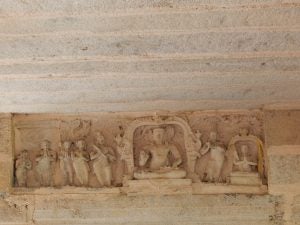The proofs for the Tiruvaymoli are finally here. It’s 520 pages. The printed manuscript is almost as tall as my Nammalvar. What a journey this has been.
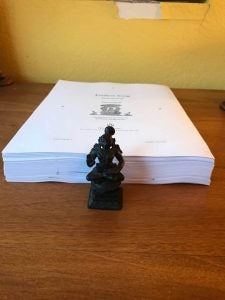

On Tamil, Temples and Translations
The proofs for the Tiruvaymoli are finally here. It’s 520 pages. The printed manuscript is almost as tall as my Nammalvar. What a journey this has been.

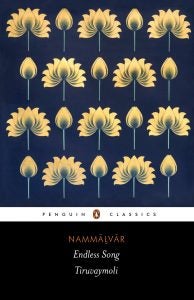
The cover of the Tiruvaymoli translation arrived this morning in my Inbox. My breath seized in delight and joy. I am honored that one of Olivia Dalrymple‘s haunting, evocative paintings once again graces the cover of one of my books. What fortune this is, that the yellow-gold lotuses that bloomed on the cover of the Tiruviruttam, glow this time, against an ink-dark body, blossoming and closing, on the cover of the Tiruvaymoli. If ever there was a painting to capture the mood, spirit and feel of the Tiruvaymoli, a garland of lotuses, an ornament to a jewel, this is surely it. Thank you, Richa, for making this happen, and thank you Olivia, for granting Penguin the necessary permissions.
A body of lotuses
from your navel, a lotus, emerged three vast worlds
your feet, lotuses, measured the three worlds
your eyes are lotuses, your hands too
Padmanābha, my ruler, I am alone
when will I reach you?
Tiruvaymoli VII.6.1
I finished the Tiruvaymoli some time ago, and thought I would take a break, recharge the brain, and then turn to the next big translation project–the Sundara Kandam of Kamban’s Ramayana. But then, a couple of mornings ago, I woke up itching to do more Nammalvar. Why? I don’t know. He composed four works, and I’ve completed two. I suppose, given my obsession about finishing things, I want to finish the set. Thankfully, they are small works. The Tiruvaciriyam (named after the meter) is just 7 verses, while the Periya Tiruvantati (The Big Antati) is 87. So, both texts almost certainly incomplete. They are attributed to Nammalvar, but there’s no concluding phala sruti, so it’s possible someone else composed them. Hard to say. But the opening of the Tiruvasiriyam is strikingly similar to the opening (thematically speaking) of the Ciriya Tirumatal, which is attributed to Tirumankai. Again, no phala sruti, so it may be Tirumankai, it could be another alvar poet, it could be someone unknown to us. Anyway, we go by what the tradition has bequeathed to us.
So, here is the opening verse of the Tiruvaciriyam. It’s quite beautiful.
Draped in crimson clouds
limned by the flaming sun
the cool glowing moon and countless stars
your jewels, your lips red coral,
your body a mountain of luminous emerald
this is how you lie in the arms
of the king of the sea:
a flame of yellow silk and shining gems
lips and eyes glittering against your leaf-dark skin
a lotus rising from your navel,
asleep on a poison-spitting serpent
in the midst of the ocean
with its crashing roaring waves
Śivaṉ Ayaṉ Indraṉ and every other god
bow before you
before your petal-soft feet
that took the three worlds.
Alvar Moksam (Jan 7, 2018), Ira Pattu, Day 10, Adhyayanotsavam, Day 20.
Here in Tirukkurungudi, Tirumankai receives moksa twice. First, to conclude the pakal pattu utsavam and the recitation of his Periya Tirumoli, then again, at the end of the Ira Pattu Utsavam as the recitation of Nammalvar’s Tiruvaymoli draws to a close. In both cases, he is himself, but is understood as being both Nammalvar and Tirumankai, just as Nammalvar is both Nambi and himself. This duplication, replication, transformation is a theme that I need to return to and explore in greater depth.
The final day is brought to a close with a recitation of the last 100 of the Tiruvaymoli, verses that the commentarial traditions have long held express Nammalvar’s final union with Vishnu. This event is enacted at the end of every Adhyayanotsavam at every Srivaishnava temple, but with always a slightly different flavor. Regardless of what form this enactment takes, the result is always a moment of enormous potency and power, and a deeply, deeply affecting experience for everyone assembled.
At Tirukkurungudi, the recitation of the last hundred moved with brisk, precise efficiency. Until we reached the sixth hundred. After this, at the conclusion of every decad, there was an elaborate tiruvaradhanai and the offering of some delectable naivedya. With each Aradhana, the tension went up just a little bit more. The recitation slowed infinitesimally with each of these aarathis, so that in the end, sound acquired a viscous quality. Each aarathi was waved a little bit more slowly, lingering on the feet, on the face, on the chest with its shining jewel. It was a true light and sound show for the ages.

In the end, they brought Tirumankai out from among where he was with the rest of the alvar. He was lovingly brought to Nambi’s feet and completely immersed in a pile of fresh, green tulasi that rose up like a little hill. The fragrance that filled the air in that moment was exotic and unfamiliar–tulasi, incense, sandal, camphor, the flowers, the food–each distinct in their own way, but mingled together, they produced a scent so unique as to be unreproducible.
As the moksa unfolds, the gosti recites the final ten verses of the Tiruvaymoli and then return us, as the poem intends, once again to the very beginning–uyarvara uyar nalam, to the highest good.
Who possesses the highest, unsurpassable goodness? That one.
Who cuts through confusion and graces the mind with goodness? That one.
Who is the overlord of the immortals who never forget? That one.
at his luminous feet that cut through affliction, bow down and rise, my mind.
Nammalvar. Tiruvaymoli. I.1.1
PS. My photographs from yesterday were a bit of a miss. I got some good shots, but I am so relieved that Selva was with me, as I know he got what I missed. It was very difficult to photograph yesterday as there was so much movement, so much happening in different places, and my position did not give me as clear a line as I would have liked. I couldn’t find a steady hand, a steady heart or a steady eye. I found myself really anxious, wanting to make sure I got the photographs I needed. This was the first time I felt this way through the 20 days of the festival, and the anxiety translated itself, predictably, in what came through. In contrast, despite all this anxiety, what I have in my mind’s eye is luminous and clear. I suppose that should suffice. But sometimes it doesn’t. But having another photographer by your side, is a sure comfort.
Adhyayanotsavam Day 19
Ira Pattu Day 9
Tiruvaymoliu 9th Hundred

The Adhyayanotsavam inches to its close. We are on the 9th night of the Ira Pattu Utsavam (Dec 6), and on the 19th day of the festival. Everyone is a bit worse for wear–exhausted, ill, moving slightly more slowly than when we began. The days are endless–beginning at 3 AM and going virtually non-stop until 1030 at night. The work in a temple is never done, especially, when it’s a temple as large as this one. Even during the down-times, when the devotees disperse home for a snack, various temple attendants, ritual specialists and functionaries are busy doing things–getting the god ready, the ritual implements polished and cleaned, the wicks oiled, the lamps lit. Over these almost twenty days, I’ve learned these rhythms–the choreography of moving through the temple. It’s incredible how quickly the body learns, not only how to move, to bend, to stay still, but the when of it as well. The women move between the walls and the pillars of the mandapa as though a unit–I always think of them undulating through space, like waves in the sea–crashing the shores of visibility and invisibility over and over again. I’ve joined their group, although I am always just a little bit behind schedule, trying to get a photograph in, or jotting down some notes. My entire vantage of the Ira Pattu festival has been from the left side of the mandapam, which is where the women are situated. I wondered yesterday, what it would look like across the aisle, from the perspective of the men. What would I see and not see? I cannot even know the answer to these questions, because there are limits to what I can see, what I am allowed to see.
Keeping with this theme, I found it difficult to see the image yesterday. Everything seemed to obscure Nambi–people, flames, walls, corners. Eventually, I was able to get a beautiful, clean straight shot, but the evening was a struggle. All of this unseeing, which seems to apropos of a dominant theme in alvar poetry–seeing god and loving god through sight.
On a lighter note, I wondered if the goddesses and the women of Tirukkurungudi color coordinated their outfits yesterday. It was a sea of blue–the goddesses in teal, the women draped in blue of every possible shade, although Nambi was in white and showered in flowers of red, gold, orange, flame. I am so glad that I somehow unconsciously got the memo and showed up in blue salwar bottoms ![]() 🙂. The colors–blue and gold– yesterday made me smile. They are California colors, and it was lovely to have a reminder of my other home, here in far away Tirunelveli.
🙂. The colors–blue and gold– yesterday made me smile. They are California colors, and it was lovely to have a reminder of my other home, here in far away Tirunelveli.
You’re my eyes. My heart thinks of all the ways
to see you, to seek you.
Gods and ascetics may struggle to see you,
I won’t stop till I reach you.
Nammalvar. Tiruvaymoli. IX.4.2
An unusual Nammalvar-Maturakavi, where he stands next to him, not with stylus in hand, but palms folded.
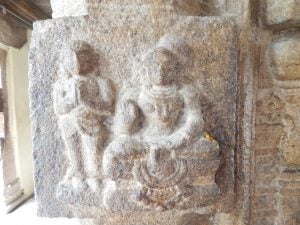
This is Nammalvar territory, so I am not at all surprised to have found many, many Nammalvars carved on pillars and lintels. I’ve found a great many pairings of Nammalvar and Ramanuja. And I found a lovely, unusual Nammalvar and Madurakavi at the temple in Varagunamangai. So far, this is the first I’ve found marking a lineal descent from Vishnu to Nammalvar to Ramanuja. An unsubtle Guruparampara located on the outer wall of the Gopuram of the Kaisini Vendan Temple, Tirupuliyangudi Temple, Tirunelveli. Looking forward to the treasures of Perunkulam, Tentiruperai and Tirukolur.
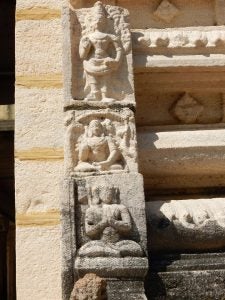
On the same note, here is one of Nammalvar with Madurakavi on one side (R) and Nathamuni on the other (L). He’s wearing a tall conical cap (recognizable today as what the Araiyars wear, and if you peer closely enough, he holds the talam in his hands). Located on the lintel, Aravindalocanan Temple, Irattai Tirupati, Tirunelveli.
Lineages are emphasized over and over again here in the Nava Tirupatis. So, I am looking forward to revisiting the paintings at Alvar Tirunagari, ones about which Anna Seastrand has written so well.
